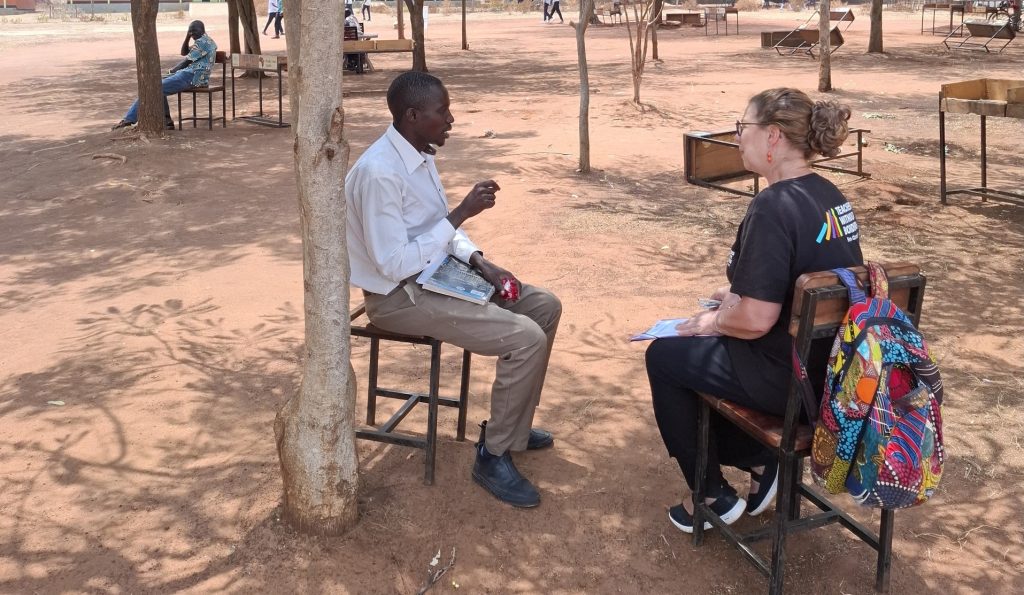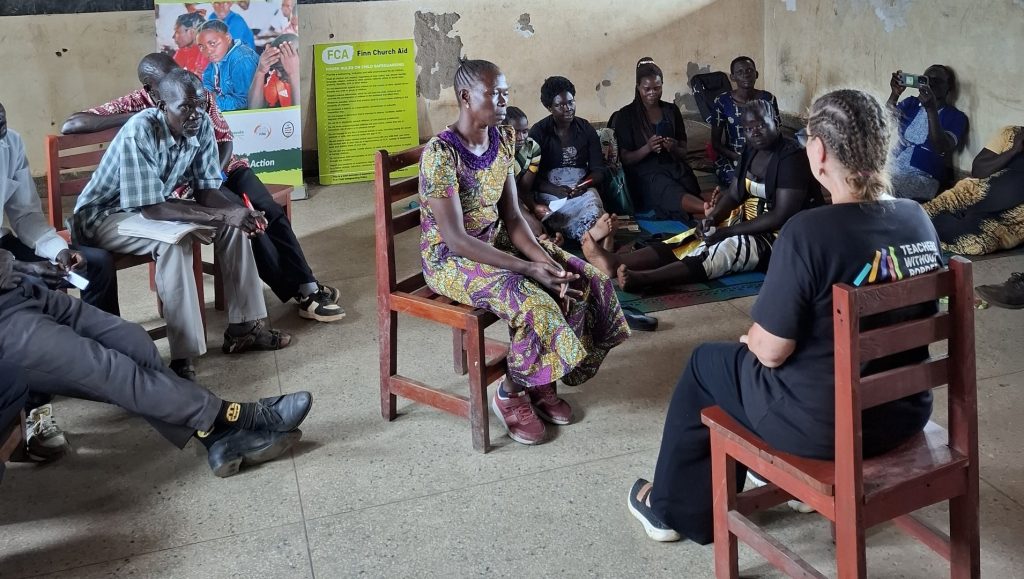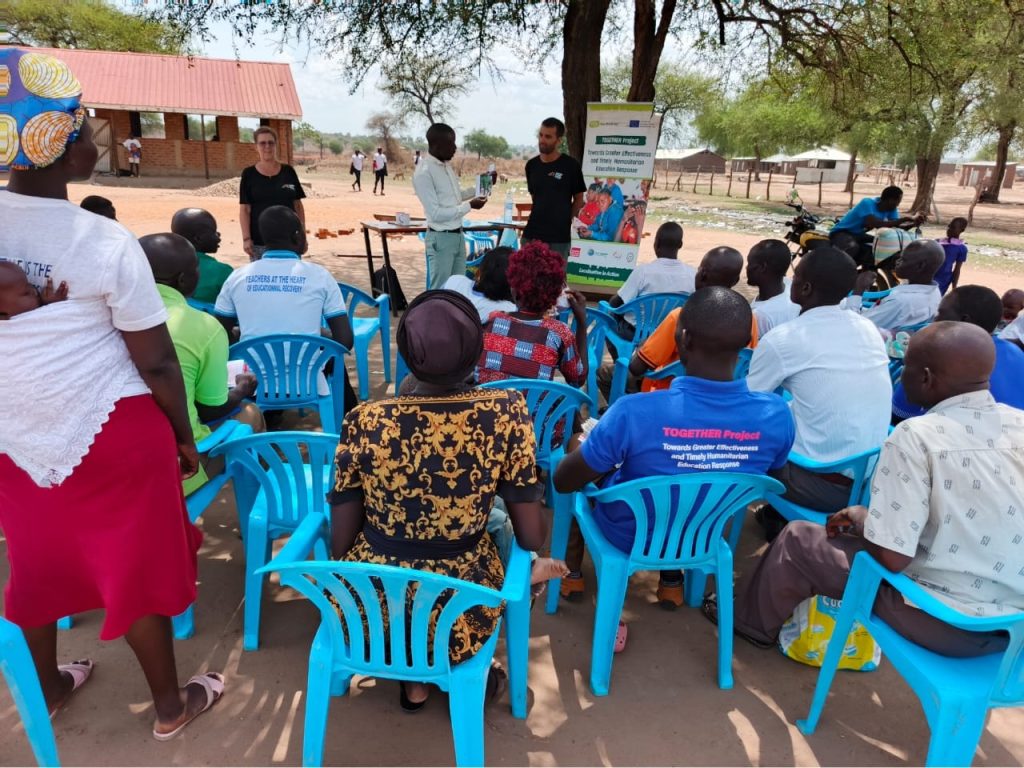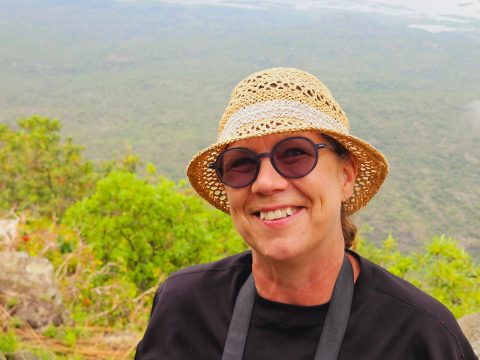‘We do this together’ – a volunteer in Uganda’s refugee settlements.

By Marjut Vaihkonen, Teachers Without Borders (TWB) volunteer
A warm welcome to the Pearl of Africa
IN EARLY February 2025, my colleague Hagos Berhane and I arrived in Obongi District, Northern Uganda, from Finland to begin our volunteer journey with Teachers Without Borders (TWB).
Finn Church Aid (FCA) works closely with Teachers Without Borders (TWB) in Uganda to enhance the quality and inclusivity of education in refugee settlements and host communities. Through this partnership, FCA leverages TWB’s expertise and volunteer network to provide targeted teacher training, professional development, and mentorship programs tailored to the unique challenges of crisis-affected contexts.
Africa isn’t exactly new to me. I’ve visited Ethiopia, Kenya, Tanzania, and Zambia. But working professionally in Uganda since February has been a very different experience from being a tourist.
Uganda, often called the Pearl of Africa, has certainly lived up to its name. Its endless greenery and stunning landscapes continue to amaze me—even after eight trips between Kampala and Obongi district, I still haven’t wanted to close my eyes for even a quick nap, I only want to soak in the views.
The people have also left a deep impression on me: Ugandans are the most welcoming and friendly people I’ve ever met. If I forget to greet someone, they make sure to call out, “How are you?”
Why I Joined TWB
Volunteering through TWB has been a long-held dream of mine. I never envisioned retirement as simply a time to rest. Instead, I wanted to use my experience to support others and FCA offered the perfect opportunity. Through this programme, I’ve been able to share my skills with teachers who work tirelessly to ensure that every child has the right to education.

It’s been a great privilege to be part of this chain. Beyond contributing professionally, I’ve gained so much: insights into African culture, exposure to education in refugee contexts, a taste of Uganda’s rich culinary offerings—goat, tilapia, millet, matoke(bananas), rolex (rolled chapati and eggs), and more and most importantly, a deeper understanding of myself.
I’m grateful for my supportive colleague Hagos and the entire FCA Uganda office team. I hope to continue volunteering in some way for as long as I’m still “young and healthy.”
The TOGETHER Project
In Uganda, I was assigned to support the Towards Greater Effectiveness and Timely Humanitarian Education Response (TOGETHER) project—an initiative implemented by Finn Church Aid (FCA) and funded by European Union Humanitarian Aid. Its goal is to provide access to quality, inclusive formal and non-formal education for South Sudanese and Sudanese refugees, asylum seekers, and children from host communities.
I work closely with Hagos on the project in Palorinya refugee settlement, Obongi district, West Nile Uganda. Our work entails bringing perspectives from the Finnish education system while also learning from the incredibly dedicated local teachers we collaborate with.
Many people ask, “What exactly are you doing there?” Here’s a glimpse into our work on the ground.
Teacher Training in Crisis Contexts
Just two weeks after settling in, we facilitated a two-day Teachers in Crisis Contexts (TiCC) training. This involves equipping educators with the skills and knowledge needed to effectively teach and support learners in challenging environments, such as refugee settlements.
While the TiCC materials were new to us, FCA had provided a comprehensive toolkit. Though the curriculum could easily fill several weeks, we condensed it into one intensive weekend. With help from the colleagues at the office, we prioritised key themes: Hagos led sessions on Teacher Wellbeing, while I focused on Learner Wellbeing, Learning Styles, and Child Development. We co-facilitated sessions on Classroom Management, quickly learning each other’s strengths, philosophies, and styles—laying the foundation for the strong collaboration that has defined our work here.
School Monitoring: Learning by Doing
We participated in school monitoring visits alongside stakeholders from the District Education Office, Office of the Prime Minister, school leadership, Village Education Committees (VECs), and implementing partners. Initially, I felt uncertain—after all, I’m not a school inspector! But the process turned out to be inclusive and multidisciplinary.
Everyone brought their own expertise: whether evaluating learning environments, school management, classroom instruction, or community engagement. I soon found my own role and perspective within this dynamic team.
Support Supervision: Encouraging, Not Evaluating
In support supervision sessions, we observed classes and reflected on teaching practices based on eight criteria: language use, atmosphere, discipline, learner-centred methods, inclusiveness, assessments, and the learning environment.
While some issues—like infrastructure—were out of the teachers’ hands, our goal was never to point out faults. Instead, we focused on creating safe spaces for growth and reflection. Most teachers already knew where they wanted to improve—we simply helped facilitate that journey with encouragement and shared dialogue.

Teachers’ Learning Circles: Sharing Successes and Struggles
We also facilitated Teachers’ Learning Circles, which are safe, peer-led spaces for teachers to discuss current classroom challenges and strategies. During one session, we revisited TiCC homework where teachers had applied one or two new classroom management tools. Whether successful or not, every experience brought valuable lessons.
We explored the “Big Five” proactive strategies—positive discipline, engagement, routines, clear expectations, and positive reinforcement—while recognising that reactive tools also have their place. Those who had tried new approaches inspired others. I highly recommend schools continue hosting these peer-led discussions to foster professional growth and camaraderie.
Child Safeguarding: Learning Through Laughter
Our Child Safeguarding sessions began with realistic classroom scenarios, prompting teachers to respond with how they would act. From their responses, we introduced FCA’s nine safeguarding principles and co-created a mind map for future reference.
Later, teachers revisited the same scenarios in shuffled groups, and the wrap-up unexpectedly turned into a joyful set of roleplays and sociodramas. The laughter and shared creativity deepened the learning, making even this serious topic memorable.
Cultural and Emotional Adjustments
FCA prepared us well for the challenges of working in a refugee-hosting district—from accommodation to the tough realities teachers face. Yet, what surprised me most was the talent, commitment, and eagerness of the teachers here. They are doing an incredible job for their learners and are genuinely enthusiastic about professional development.
Another delightful adjustment has been the food. Uganda tastes amazing—especially when meals are shared with friends. From matoke to cassava, and from guavas to the beloved rolex, every dish has added to this rich experience.
The Power of “TOGETHER”
The most fulfilling part of this TWB experience has been the fieldwork—being present with teachers, learning alongside them, and exchanging ideas. We didn’t come with all the answers. What we brought was enthusiasm, open minds, and a willingness to co-create solutions.
The teachers here have embraced every part of this journey—discussions, roleplays, peer sharing, and games. They’ve reminded us how powerful collaborative learning can be. At the heart of it all is one simple truth: We do this together.
—
Read more about Teachers Without Borders and how to get involved if you are an education professional.
